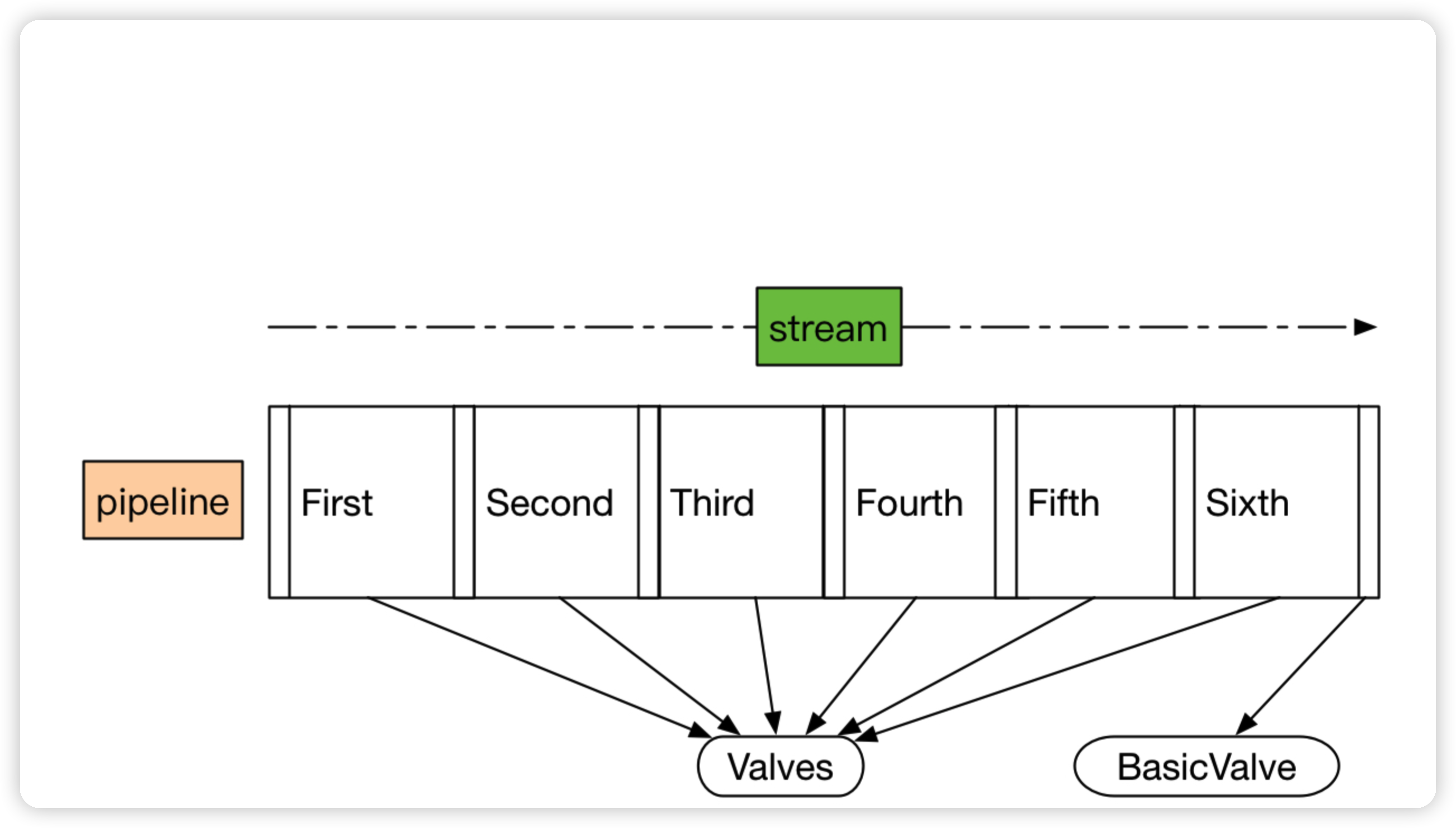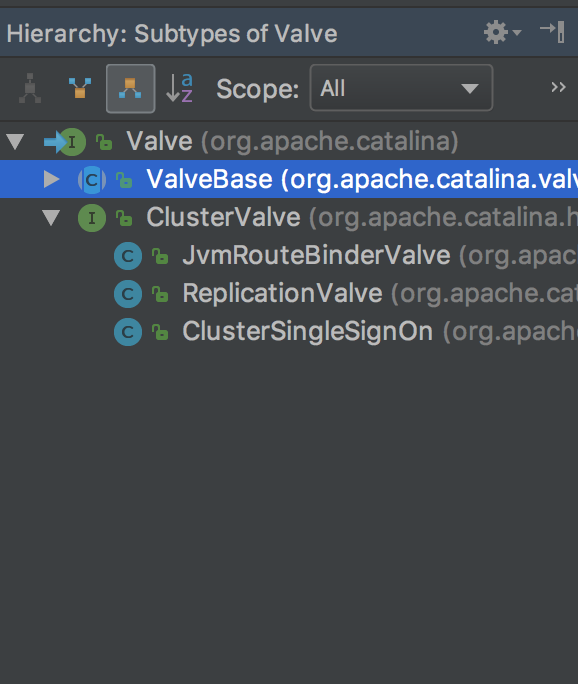【Tomcat 源码分析】Pipeline 与 Valve 的秘密花园
- 2024-09-04 辽宁
本文字数:8821 字
阅读完需:约 29 分钟
前言
“在上一篇《Tomcat 源码分析(二)》中,我们对 Tomcat 的 Pipeline 和 Valve 组件进行了初步的探讨,并绘制了其整体架构图。本篇将深入源码,对这些组件进行更加细致的剖析。”

Valve
Valve 作为业务逻辑的执行者,在 Tomcat 的请求处理链中扮演着基础而又关键的角色。接下来,我们将深入探究 Valve 接口,了解其所提供的方法。
public interface Valve { // 获取下一个阀门 public Valve getNext(); // 设置下一个阀门 public void setNext(Valve valve); // 后台执行逻辑,主要在类加载上下文中使用到 public void backgroundProcess(); // 执行业务逻辑 public void invoke(Request request, Response response) throws IOException, ServletException; // 是否异步执行 public boolean isAsyncSupported();}
Contained
ValveBase、Pipeline 以及其他相关组件均实现了 Contained 接口,用于管理其所属的容器。Contained 接口提供了简单而有效的 get/set 容器操作方法,方便组件在运行时动态地获取或设置其容器引用。
public interface Contained {
/** * Get the {@link Container} with which this instance is associated. * * @return The Container with which this instance is associated or * <code>null</code> if not associated with a Container */ Container getContainer();
/** * Set the <code>Container</code> with which this instance is associated. * * @param container The Container instance with which this instance is to * be associated, or <code>null</code> to disassociate this instance * from any Container */ void setContainer(Container container);}
ValveBase
Tomcat 中的 Valve 组件呈现出清晰的继承体系,绝大多数 Valve 都以 ValveBase 为基类。为了深入理解 Valve 的工作原理,我们有必要对 ValveBase 这个抽象类进行细致的分析。

public abstract class ValveBase extends LifecycleMBeanBase implements Contained, Valve { // 国际化管理器,可以支持多国语言 protected static final StringManager sm = StringManager.getManager(ValveBase.class);
//------------------------------------------------------ Instance Variables
// 无参构造方法,默认不支持异步 public ValveBase() { this(false); } // 有参构造方法,可传入异步支持标记 public ValveBase(boolean asyncSupported) { this.asyncSupported = asyncSupported; }
//------------------------------------------------------ Instance Variables
// 异步标记 protected boolean asyncSupported; // 所属容器 protected Container container = null; // 容器日志组件对象 protected Log containerLog = null; // 下一个阀门 protected Valve next = null;
//-------------------------------------------------------------- Properties
// 获取所属容器 @Override public Container getContainer() { return container; } // 设置所属容器 @Override public void setContainer(Container container) { this.container = container; } // 是否异步执行 @Override public boolean isAsyncSupported() { return asyncSupported; } // 设置是否异步执行 public void setAsyncSupported(boolean asyncSupported) { this.asyncSupported = asyncSupported; } // 获取下一个待执行的阀门 @Override public Valve getNext() { return next; } // 设置下一个待执行的阀门 @Override public void setNext(Valve valve) { this.next = valve; }
//---------------------------------------------------------- Public Methods
// 后台执行,子类实现 @Override public void backgroundProcess() { // NOOP by default } // 初始化逻辑 @Override protected void initInternal() throws LifecycleException { super.initInternal(); // 设置容器日志组件对象到当前阀门的containerLog属性 containerLog = getContainer().getLogger(); } // 启动逻辑 @Override protected synchronized void startInternal() throws LifecycleException { setState(LifecycleState.STARTING); } // 停止逻辑 @Override protected synchronized void stopInternal() throws LifecycleException { setState(LifecycleState.STOPPING); } // 重写toString,格式为[${containerName}] @Override public String toString() { StringBuilder sb = new StringBuilder(this.getClass().getName()); sb.append('['); if (container == null) { sb.append("Container is null"); } else { sb.append(container.getName()); } sb.append(']'); return sb.toString(); }
// -------------------- JMX and Registration --------------------
// 设置获取MBean对象的keyProperties,格式如:a=b,c=d,e=f... @Override public String getObjectNameKeyProperties() { StringBuilder name = new StringBuilder("type=Valve");
Container container = getContainer();
name.append(container.getMBeanKeyProperties());
int seq = 0;
// Pipeline may not be present in unit testing Pipeline p = container.getPipeline(); if (p != null) { for (Valve valve : p.getValves()) { // Skip null valves if (valve == null) { continue; } // Only compare valves in pipeline until we find this valve if (valve == this) { break; } if (valve.getClass() == this.getClass()) { // Duplicate valve earlier in pipeline // increment sequence number seq ++; } } }
if (seq > 0) { name.append(",seq="); name.append(seq); }
String className = this.getClass().getName(); int period = className.lastIndexOf('.'); if (period >= 0) { className = className.substring(period + 1); } name.append(",name="); name.append(className);
return name.toString(); } // 获取所属域,从container获取 @Override public String getDomainInternal() { Container c = getContainer(); if (c == null) { return null; } else { return c.getDomain(); } }}
Pipeline
Pipeline 可视作一个 Valve 的容器,这些 Valve 在 Pipeline 中首尾相连,形成一条处理链。当请求抵达 Pipeline 时,它会沿着这条链逐个激活 Valve,触发每个 Valve 的 invoke()方法,从而完成一系列的业务处理。
具体代码如下:
public interface Pipeline { // ------------------------------------------------------------- Properties
// 获取基本阀门 public Valve getBasic(); // 设置基本阀门 public void setBasic(Valve valve);
// --------------------------------------------------------- Public Methods
// 添加阀门 public void addValve(Valve valve); // 获取阀门数组 public Valve[] getValves(); // 删除阀门 public void removeValve(Valve valve); // 获取首个阀门 public Valve getFirst(); // 管道内所有阀门是否异步执行 public boolean isAsyncSupported(); // 获取管道所属的容器 public Container getContainer(); // 设置管道所属的容器 public void setContainer(Container container); // 查找非异步执行的所有阀门,并放置到result参数中,所以result不允许为null public void findNonAsyncValves(Set<String> result);}
StandardPipeline
接下来,我们将目光转向** StandardPipeline,这是 Pipeline 接口的唯一实现**。尽管代码规模较大,但其内部的实现逻辑却清晰易懂。
public class StandardPipeline extends LifecycleBase implements Pipeline, Contained {
private static final Log log = LogFactory.getLog(StandardPipeline.class);
// ----------------------------------------------------------- Constructors
// 构造一个没有所属容器的管道 public StandardPipeline() { this(null); }
// 构造一个有所属容器的管道 public StandardPipeline(Container container) { super(); setContainer(container); }
// ----------------------------------------------------- Instance Variables
/** * 基本阀门,最后执行的阀门 */ protected Valve basic = null;
/** * 管道所属的容器 */ protected Container container = null;
/** * 管道里面的首个执行的阀门 */ protected Valve first = null;
// --------------------------------------------------------- Public Methods
// 是否异步执行,如果一个阀门都没有,或者所有阀门都是异步执行的,才返回true @Override public boolean isAsyncSupported() { Valve valve = (first!=null)?first:basic; boolean supported = true; while (supported && valve!=null) { supported = supported & valve.isAsyncSupported(); valve = valve.getNext(); } return supported; }
// 查找所有未异步执行的阀门 @Override public void findNonAsyncValves(Set<String> result) { Valve valve = (first!=null) ? first : basic; while (valve != null) { if (!valve.isAsyncSupported()) { result.add(valve.getClass().getName()); } valve = valve.getNext(); } }
// ------------------------------------------------------ Contained Methods
// 获取所属容器 @Override public Container getContainer() { return (this.container); }
// 设置所属容器 @Override public void setContainer(Container container) { this.container = container; }
// 初始化逻辑,默认没有任何逻辑 @Override protected void initInternal() { // NOOP }
// 开始逻辑,调用所有阀门的start方法 @Override protected synchronized void startInternal() throws LifecycleException { // Start the Valves in our pipeline (including the basic), if any Valve current = first; if (current == null) { current = basic; } while (current != null) { if (current instanceof Lifecycle) ((Lifecycle) current).start(); current = current.getNext(); }
setState(LifecycleState.STARTING); }
// 停止逻辑,调用所有阀门的stop方法 @Override protected synchronized void stopInternal() throws LifecycleException { setState(LifecycleState.STOPPING);
// Stop the Valves in our pipeline (including the basic), if any Valve current = first; if (current == null) { current = basic; } while (current != null) { if (current instanceof Lifecycle) ((Lifecycle) current).stop(); current = current.getNext(); } }
// 销毁逻辑,移掉所有阀门,调用removeValve方法 @Override protected void destroyInternal() { Valve[] valves = getValves(); for (Valve valve : valves) { removeValve(valve); } }
/** * 重新toString方法 */ @Override public String toString() { StringBuilder sb = new StringBuilder("Pipeline["); sb.append(container); sb.append(']'); return sb.toString(); }
// ------------------------------------------------------- Pipeline Methods
// 获取基础阀门 @Override public Valve getBasic() { return (this.basic); }
// 设置基础阀门 @Override public void setBasic(Valve valve) { // Change components if necessary Valve oldBasic = this.basic; if (oldBasic == valve) return;
// Stop the old component if necessary // 老的基础阀门会被调用stop方法且所属容器置为null if (oldBasic != null) { if (getState().isAvailable() && (oldBasic instanceof Lifecycle)) { try { ((Lifecycle) oldBasic).stop(); } catch (LifecycleException e) { log.error("StandardPipeline.setBasic: stop", e); } } if (oldBasic instanceof Contained) { try { ((Contained) oldBasic).setContainer(null); } catch (Throwable t) { ExceptionUtils.handleThrowable(t); } } }
// Start the new component if necessary // 新的阀门会设置所属容器,并调用start方法 if (valve == null) return; if (valve instanceof Contained) { ((Contained) valve).setContainer(this.container); } if (getState().isAvailable() && valve instanceof Lifecycle) { try { ((Lifecycle) valve).start(); } catch (LifecycleException e) { log.error("StandardPipeline.setBasic: start", e); return; } }
// Update the pipeline // 替换pipeline中的基础阀门,就是讲基础阀门的前一个阀门的next指向当前阀门 Valve current = first; while (current != null) { if (current.getNext() == oldBasic) { current.setNext(valve); break; } current = current.getNext(); }
this.basic = valve; }
// 添加阀门 @Override public void addValve(Valve valve) { // Validate that we can add this Valve // 设置所属容器 if (valve instanceof Contained) ((Contained) valve).setContainer(this.container);
// Start the new component if necessary // 调用阀门的start方法 if (getState().isAvailable()) { if (valve instanceof Lifecycle) { try { ((Lifecycle) valve).start(); } catch (LifecycleException e) { log.error("StandardPipeline.addValve: start: ", e); } } }
// Add this Valve to the set associated with this Pipeline // 设置阀门,将阀门添加到基础阀门的前一个 if (first == null) { first = valve; valve.setNext(basic); } else { Valve current = first; while (current != null) { if (current.getNext() == basic) { current.setNext(valve); valve.setNext(basic); break; } current = current.getNext(); } }
container.fireContainerEvent(Container.ADD_VALVE_EVENT, valve); }
// 获取阀门数组 @Override public Valve[] getValves() { ArrayList<Valve> valveList = new ArrayList<>(); Valve current = first; if (current == null) { current = basic; } while (current != null) { valveList.add(current); current = current.getNext(); }
return valveList.toArray(new Valve[0]); }
// JMX方法,在此忽略 public ObjectName[] getValveObjectNames() { ArrayList<ObjectName> valveList = new ArrayList<>(); Valve current = first; if (current == null) { current = basic; } while (current != null) { if (current instanceof JmxEnabled) { valveList.add(((JmxEnabled) current).getObjectName()); } current = current.getNext(); }
return valveList.toArray(new ObjectName[0]); }
// 移除阀门 @Override public void removeValve(Valve valve) { Valve current; if(first == valve) { // 如果待移出的阀门是首个阀门,则首个阀门的下一个阀门变成首个阀门 first = first.getNext(); current = null; } else { current = first; } // 遍历阀门集合,并进行移除 while (current != null) { if (current.getNext() == valve) { current.setNext(valve.getNext()); break; } current = current.getNext(); }
if (first == basic) first = null;
// 设置阀门所属容器为null if (valve instanceof Contained) ((Contained) valve).setContainer(null);
// 调用待移除阀门的stop方法和destroy方法,并触发移除阀门事件 if (valve instanceof Lifecycle) { // Stop this valve if necessary if (getState().isAvailable()) { try { ((Lifecycle) valve).stop(); } catch (LifecycleException e) { log.error("StandardPipeline.removeValve: stop: ", e); } } try { ((Lifecycle) valve).destroy(); } catch (LifecycleException e) { log.error("StandardPipeline.removeValve: destroy: ", e); } }
container.fireContainerEvent(Container.REMOVE_VALVE_EVENT, valve); }
// 获取首个阀门,如果阀门列表为null,返回基础阀门 @Override public Valve getFirst() { if (first != null) { return first; } return basic; }}
总结
经过对代码的深入剖析,我们发现其中蕴含着两种经典的设计模式:
模板方法模式: Pipeline 接口作为抽象类,定义了请求处理的整体流程骨架。StandardPipeline 作为具体子类,通过实现抽象方法来填充骨架中的细节,从而定制化请求处理过程。这种模式赋予了系统良好的扩展性,使得我们可以通过继承 StandardPipeline 来创建新的 Pipeline 实现。
责任链模式: Valve 的组织方式体现了责任链模式的精髓。每个 Valve 都持有指向下一个 Valve 的引用,形成一条处理链。当请求到达时,它沿着这条链依次传递,直到被某个 Valve 处理或到达链尾。这种模式将请求的处理过程分解成一系列的环节,每个环节负责处理特定的业务逻辑,从而提高了系统的模块化和可维护性。
如有问题,欢迎微信搜索【码上遇见你】。
免费的Chat GPT可微信搜索【AI贝塔】进行体验,无限使用。
好了,本章节到此告一段落。希望对你有所帮助,祝学习顺利。
版权声明: 本文为 InfoQ 作者【派大星】的原创文章。
原文链接:【http://xie.infoq.cn/article/7d60c8cc0bf158193e4846838】。
本文遵守【CC BY-NC-SA】协议,转载请保留原文出处及本版权声明。
派大星
微信搜索【码上遇见你】,获取更多精彩内容 2021-12-13 加入
微信搜索【码上遇见你】,获取更多精彩内容








评论